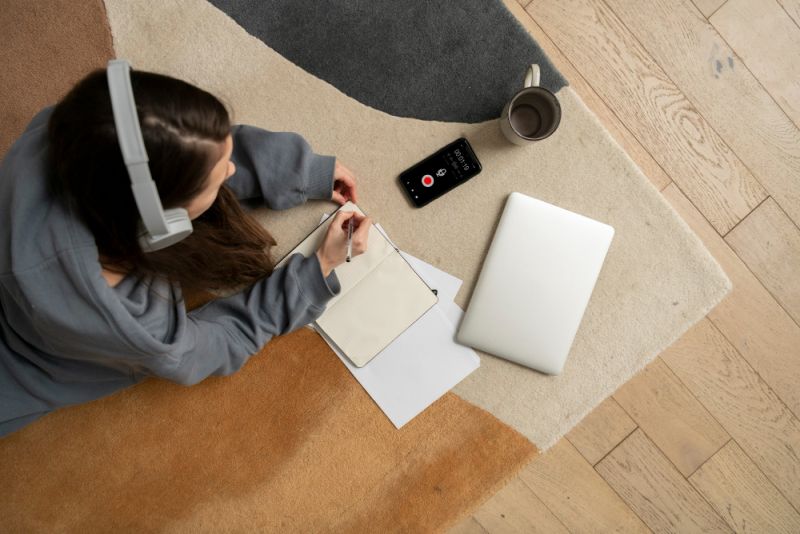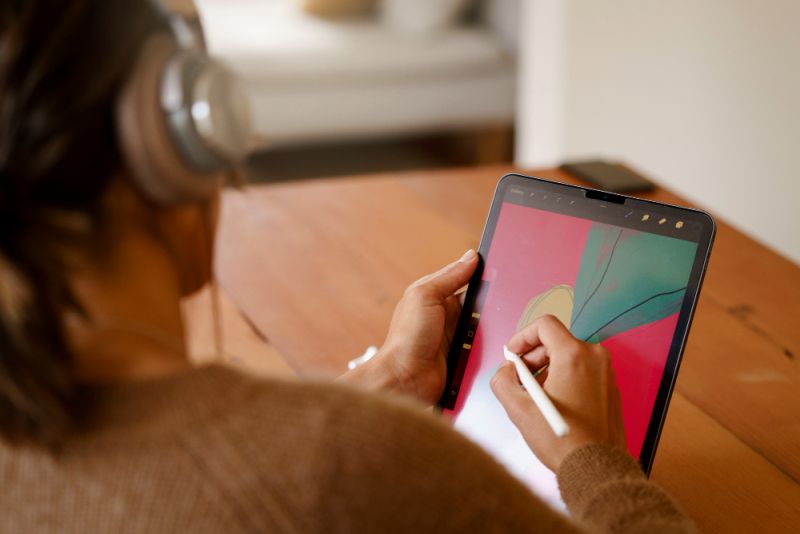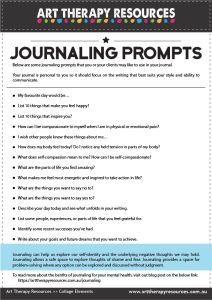THIS POST INCLUDES:
1. Digital Journaling in Art Therapy
2. Digital Journaling Tools
3. Digital Journaling in Practice
4. Ethics and Confidentiality Considerations
5. Free Download Journaling Prompts for Mental Health
DIGITAL JOURNALING IN ART THERAPY

As art therapy continues to adapt to new technologies, digital journaling has emerged as a powerful tool for reflection and personal growth. Digital journaling platforms offer art therapists innovative ways to support clients’ emotional exploration and self-expression, integrating visual and multimedia elements that go beyond traditional journaling.
Digital journaling platforms have evolved to include various tools that facilitate journaling in a digital format, offering features like text entry, multimedia support, and personalized templates. These platforms support multiple modes of expression, allowing clients to document their thoughts visually and creatively.
Some tools emphasize visual creativity, while others offer multimedia integration, enhancing the journaling experience. Understanding the range of these tools enables art therapists to introduce clients to dynamic journaling methods that align with their therapeutic goals.
Benefits of Digital Journaling in Art Therapy
Digital journaling expands the benefits of traditional journaling by incorporating multimedia elements such as images, audio, and video. For clients who may struggle to express emotions solely through text, multimedia integration provides alternative avenues for self-reflection.
Adding photos, voice recordings, or sketches helps clients represent their experiences more richly and authentically, facilitating a deeper exploration of emotions. In turn, art therapists can engage with a more comprehensive picture of the client’s inner world, leading to more effective support and guidance.
Enhancing Therapeutic Reflection Through Technology
Digital journaling platforms allow art therapists to use technology to foster therapeutic reflection in unique ways. By guiding clients in integrating different media—like images, drawings, or audio notes—therapists can encourage clients to explore emotions and experiences from multiple perspectives. This holistic approach can help clients uncover insights they might not reach through text alone. Moreover, many digital journaling platforms feature intuitive interfaces that make them accessible, allowing clients to focus on the reflective process rather than navigating complex technology.
Digital Journaling in Art Therapy Practice
For art therapists interested in incorporating digital journaling into their practice, selecting suitable platforms is crucial. Each platform brings distinct features that may suit different therapeutic needs, whether by enabling visual expression, facilitating multimedia journaling, or supporting interactivity.
DIGITAL JOURNALING TOOLS

Artful Expression with Procreate
Procreate is primarily a digital illustration app, but its versatility makes it an effective journaling tool for clients drawn to visual art. Therapists can guide clients in creating visual narratives or expressive artworks, using Procreate’s array of brushes and textures to explore emotions in depth. The app’s layering options allow clients to build complex images that represent layered feelings, while features like time-lapse recording can allow clients to reflect on their creative process.
Capturing Moments with Day One
Day One is a well-known digital journaling app with multimedia support, making it suitable for clients who want a balance between text and visual journaling. Clients can seamlessly document their thoughts, feelings, and artistic creations, integrating photos and voice recordings into entries. This feature helps create a personal digital archive that tracks their progress and reflections, giving both clients and therapists a visual timeline of growth and insights over time.
Interactive Reflections with Penzu
Penzu is an online journaling platform known for its interactive and user-friendly features. Art therapists can recommend Penzu to clients who value ease of access and multimedia integration in their journaling. Penzu supports private, password-protected entries and has options for inserting photos and sketches, which add a unique layer of reflection. For clients who may prefer privacy in their reflective process, Penzu’s security features make it an attractive choice.
Digital Journaling for Art Therapists: Building Connections
Digital journaling not only enhances client self-reflection but also offers art therapists new ways to foster connections with clients. Digital journals provide opportunities for ongoing dialogue and collaborative insights, even between sessions.
DIGITAL JOURNALING IN PRACTICE
Facilitating Therapist-Client Collaboration
Some digital journaling platforms allow for shared access, enabling therapists to review and respond to clients’ journal entries remotely. This option is invaluable for clients who may benefit from real-time feedback or who need additional support outside of scheduled sessions. By maintaining a connection through digital journaling, art therapists can nurture a sense of continuity in therapy, offering timely insights or encouragement that reinforce clients’ progress.
Harnessing Multimedia for Deeper Insights
One of the key advantages of digital journaling is the depth of insight therapists can gain by observing clients’ multimedia entries. Visual or audio elements can reveal layers of emotion that text alone may not convey. For instance, a client may create a collage of images that represent various aspects of their identity, or record a voice entry expressing emotions they find challenging to articulate in writing. Observing these multimedia entries can help therapists better understand clients’ experiences and create more personalized, effective interventions.
Tailoring Digital Journaling to Individual Needs
Every client’s therapeutic experience is unique, and digital journaling allows therapists to tailor journaling exercises to meet each individual’s preferences and therapeutic needs. For example, a client interested in visual storytelling might benefit most from apps like Procreate, while someone who values written reflection could find Day One’s balance of text and image entry more suitable. Collaborating with clients to identify the platform that resonates with their expression style fosters engagement and supports more impactful therapy sessions.
Practical Tips for Integrating Digital Journaling into Therapy
Incorporating digital journaling into art therapy can be both rewarding and challenging. To help therapists navigate this integration, below are some practical strategies for ensuring a smooth transition:
– Set Clear Guidelines: Explain the benefits of digital journaling to clients and outline expectations for privacy and sharing.
– Provide Technical Support: Some clients may be unfamiliar with digital journaling tools; a brief tutorial can boost their confidence.
– Define Boundaries: Encourage clients to share entries selectively rather than feeling pressured to open their entire journal.
– Encourage Exploration: Allow clients the freedom to experiment with different platforms and tools to find what feels most authentic.
– Foster Consistency: Suggest regular journaling, whether daily or weekly, to help clients develop a reflective habit.
– Incorporate Feedback: Periodically discuss clients’ experiences with digital journaling, adjusting approaches as needed.
By incorporating these strategies, therapists can help clients find value and fulfillment in digital journaling as part of their therapeutic work.
Embracing Digital Journaling in Art Therapy
Digital journaling offers art therapists an exciting array of tools to enhance clients’ therapeutic reflection. The ability to integrate multimedia elements makes digital journaling particularly well-suited to art therapy, allowing clients to explore their experiences in rich, varied ways. As therapists continue to adapt to these evolving tools, digital journaling may become a staple in therapeutic practices, providing clients with a flexible, creative outlet for self-exploration and growth. With thoughtful integration, art therapists can harness the potential of digital journaling to deepen the therapeutic experience, supporting clients in achieving lasting personal insights and resilience.
ETHICAL AND CONFIDENTIALITY CONSIDERATIONS

When integrating digital journaling into art therapy, art therapists must navigate critical ethical and confidentiality aspects to protect client information and maintain professional standards. While digital platforms offer unique opportunities for creative expression, they also introduce potential privacy and data security risks. Art therapists should carefully evaluate each tool and platform to ensure they meet ethical requirements and align with client confidentiality needs.
Privacy and Data Security
Client confidentiality is paramount in therapy, and digital journaling platforms must uphold strict privacy standards. Before recommending a platform, therapists should review its data security policies, including encryption measures, access controls, and data storage practices. Platforms that offer end-to-end encryption and password-protected accounts provide an additional layer of security, helping to safeguard sensitive client information. Art therapists should prioritize platforms with robust privacy policies that protect client entries from unauthorized access.
Informed Consent and Transparency
Informed consent is essential when introducing digital journaling into the therapeutic process. Art therapists must provide clients with comprehensive information on how digital journaling works, including potential risks, data storage practices, and who may have access to their entries. By clearly communicating these aspects and ensuring that clients understand them, therapists promote informed decision-making. Clients should also be aware of their right to withdraw consent or limit the extent to which they use digital journaling in therapy.
Client Control Over Shared Content
Respecting client autonomy in deciding what to share with their therapist is critical. Art therapists should clarify that clients can choose specific entries to discuss rather than feeling obligated to share their entire digital journal. Setting these boundaries helps clients feel comfortable and in control of their therapeutic journey. Art therapists might also suggest creating separate entries that are exclusively private, allowing clients to reflect freely without concerns about disclosure.
Data Ownership and Management
A key consideration in digital journaling is data ownership. Some platforms retain ownership of user content, which could conflict with confidentiality standards in therapy. Art therapists should verify that clients retain full ownership of their data and that the platform does not have rights to use it in any way outside of the client’s own access. Furthermore, therapists should guide clients on options for exporting or deleting data if they decide to stop using a particular platform, ensuring clients have full control over their digital journaling records.
Compliance with Legal and Professional Standards
Therapists are bound by legal and professional standards regarding client confidentiality, particularly when using third-party applications. Art therapists must consider these regulations when selecting a digital journaling platform, especially if they operate in jurisdictions with stringent data privacy laws. Consulting relevant legal guidelines and industry best practices can help art therapists align their digital journaling practices with these standards.
Best Practices for Ethical Digital Journaling in Therapy
To maintain high ethical standards while integrating digital journaling, art therapists can follow these best practices:
– Regularly Review Platform Policies: Periodically revisit the privacy and data policies of any journaling app or platform used to stay updated on changes.
– Educate Clients on Security: Share tips on creating strong passwords, securing their devices, and minimizing the use of public Wi-Fi when accessing digital journaling platforms.
– Use Secure Communication Channels: For clients who share entries remotely, encourage them to use encrypted methods of communication, especially if files are transferred or discussed outside of therapy sessions.
– Set and Revisit Boundaries: Have ongoing discussions about what clients are comfortable sharing through digital journaling, reinforcing their right to privacy.
By addressing these ethical and confidentiality considerations, art therapists can integrate digital journaling responsibly, upholding trust and integrity while leveraging the therapeutic benefits of digital tools.
FREE DOWNLOAD: Art Therapy Exercise
SIGN UP below to gain access to our RESOURCE LIBRARY and download the FREE Art Therapy Exercise.

BUILD YOUR ART THERAPY REFERENCE MATERIALS:
Pin this image to your Pinterest board.

SHARE KNOWLEDGE & PASS IT ON:
If you’ve enjoyed this post, please share it on Facebook, Twitter, Pinterest. Thank you!

